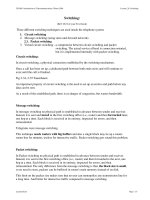Lecture 26 glaciers
Bạn đang xem bản rút gọn của tài liệu. Xem và tải ngay bản đầy đủ của tài liệu tại đây (5.14 MB, 55 trang )
Today:
Chapter 12:
Glaciers & glaciation
What is a glacier?
Glaciers are:
Thick deposits of snow and ice.
Form on land.
Flow downhill by gravity.
Basic types:
• Alpine, or mountain
• Piedmont (small ice caps)
• Continental ice caps
Part of Earth’s hydrological cycle
Fig. 22.01 b
Stephen Marshak
Glaciers form where more snow accumulates
in winter than melts in the summer.
Types of glaciers…
Fig. 22.04 a
W. W. Norton
The Greenland ice cap…
Fig. 22.05 a
W. W. Norton. Modified from Flint,
1971
The Antarctic ice cap…
Fig. 22.05 b
Fig. 22.04 c
Stephen Marshak
At any given time, snow and ice accumulation
on the Earth varies with elevation and latitude.
Fig. 22.06
As snow
accumulates and is
buried to greater
and greater depths,
it begins to change
crystal form
and density,
progressing
through a series
of transitions that
lead to an increase
grain size and
granularity.
Flowing ice…
Accumulations
of glacial ice
flow down slope
under the
influence of
gravity…
Ice flows downhill under the influence of gravity.
The rate depends on thickness and slope.
Fig. 22.11 c
W. W. Norton
How a glacier moves: Plastic flow.
Fig. 22.11 b
W. W. Norton
Glacial ice behaves as a brittle solid down to a
depth of 50-60 meters and below that depth,
as a plastic solid.
This forms
deep fractures
(crevasses)
at the surface
of the glacier.
Fig. 22.08 c
W. W. Norton
Velocity of ice flow is highest in the center
of the flowing mass and decreases to a minimum
where in contact with bedrock.
Fig. 22.10 b
W. W. Norton. Modified from
Raymond, 1971
Announcements:
Final Exam is Wednesday, May 14 at 2:40PM
in this room.
Bring your student ID and a pencil!
Fig. 22.01 b
Papers are due by 5PM tomorrow.
Turn in a hard copy of paper to the front
desk of the Geological Sciences Dept.
(6th floor of this building) and ask
Stephen
Marshak
that they time stamp
it and
place it in my
mailbox.
Review for final exam will be held this Friday
at 1:40-2:30PM. Come to this room 15 minutes
before for info. on meeting place.
Today’s Lecture:
Chapter 22:
Glacial erosion.
Fig. 22.01 b
Glacial deposition.
Causes of glaciation.
ChapterStephen
23:Read Marshak
for Final
Aspects of global change.
How a glacier moves: Internal flow.
Cold glaciers
Fig. 22.08 b
W. W. Norton
How a glacier moves…basal slip.
Warm glaciers…
Fig. 22.08 a
W. W. Norton
Integrated model of glacier movement…
Fig. 22.10 a
W. W. Norton
Glacier formation/movement
Glacier “budget”
Balance between accumulation
above snowline & loss (“ablation”)
below.
Snowline
Lower limit of “zone of
accumulation”
Zone of wastage
Net loss (ablation) at
the terminus.
Calving
Large ice pieces break off
at terminus where glacier
enters water.
Whether a glacier is advancing or retreating depends
on the balance between accumulation at the head
of the glacier and ablation (loss) at the terminus.
Fig. 22.13 a
W. W. Norton
Fig. 22.13 b
W. W. Norton









